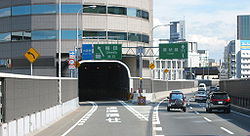
Gate Tower Building
Encyclopedia

Fukushima-ku, Osaka
is one of 24 wards of Osaka city, Japan.The ward is primarily a residential quarter, but has some office buildings and a commercial district, as well as factories and wholesale businesses....
, Japan. It is notable because a highway passes through the building. It has been nicknamed "beehive" referring to its appearance as a "bustling place".
Overview
The building has a double core construction, with a circular cross section. The Umeda Exit of the Ikeda Route of the Hanshin ExpresswayHanshin Expressway
The is a network of expressways surrounding Osaka, Kobe and Kyoto, Japan. Operated by , it opened in 1962.Portions of the Hanshin Expressway collapsed during the Kobe earthquake on January 17, 1995. These sections were rebuilt by 1996...
system (when exiting the highway from the direction of Ikeda) passes through the fifth through seventh floors of this building. The highway is the tenant of those floors. The elevator passes through the floors without stopping: floor 4 being followed by floor 8. The floors through which the highway passes consist of elevators, stairways and machinery. The highway does not make contact with the building. It passes through as a bridge, held up by supports next to the building. The highway is surrounded by a structure to protect the building from noise and vibration. The roof has a helipad
Helipad
Helipad is a common abbreviation for helicopter landing pad, a landing area for helicopters. While helicopters are able to operate on a variety of relatively flat surfaces, a fabricated helipad provides a clearly marked hard surface away from obstacles where a helicopter can safely...
.
History
Wood and charcoal business held the property rights for this plot of land since the early Meiji periodMeiji period
The , also known as the Meiji era, is a Japanese era which extended from September 1868 through July 1912. This period represents the first half of the Empire of Japan.- Meiji Restoration and the emperor :...
, but the gradual move to other sources of fuel resulted in the deterioration of those company buildings. In 1983, the redevelopment of the area was decided upon, but building permits were refused because the highway was already being planned to be built over this land. The property rights' holders refused to give up, and negotiated with the Hanshin Expressway corporation for approximately 5 years to reach the current solution.
Although normally highway corporations purchase the land they build a highway on or over, it is not guaranteed to succeed and therefore issues like this can arise.
For that reason, the highway laws, city planning laws, city redevelopment laws and building codes were partly revised in 1989 to permit a so-called that allows the unified development of highways and buildings in the same space. This system was originally designed to facilitate the construction of the second Ring Road in the vicinity of Toranomon, Minato-ku
Toranomon, Minato, Tokyo
is a business district of Minato, Tokyo. Literally meaning "Tiger's Gate," Toranomon was the name of the southernmost gate of Edo Castle. It is home to the Hotel Okura Tokyo....
, Tokyo, but in the end was not applied there. Instead, the system was put into effect in the construction of the Gate Tower Building, becoming Japan's first building to have a highway pass through it. Normally, highways are still built underground in these cases, and passing through a building is an extremely rare occurrence.
Profile
- Address: Fukushima 5-4-21, Fukushima-ku, Osaka
- Completed: 1992
- Site area: 2,353 m2
- Construction area: 760 m2
- Total floor area: 7,956 m2
- Structure: Reinforced concrete and partly steel frame
- Height: 71.9 m
- Floors: 16 floors above ground, 2 floors underground and 1 floor counted as the mechanical penthouse
- Purpose: Office building
- Client: Suezawa Sangyo Co. Ltd.
- Designer: Azusa Sekkei and Yamamoto-Nishihara Kenchiku Sekkei Jimusho
- Builder: Sato Kogyo Co. Ltd.

